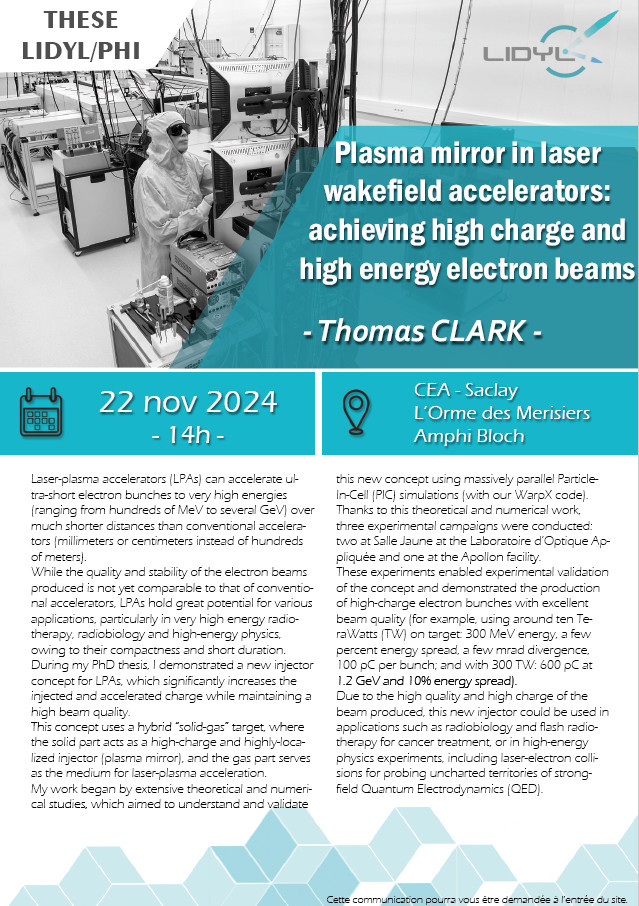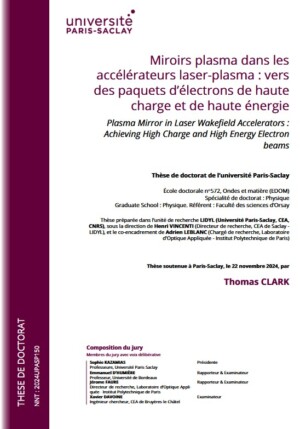Laser-plasma accelerators (LPAs) can accelerate ultra-short electron bunches to very high energies (ranging from hundreds of MeV to several GeV) over much shorter distances than conventional accelerators (millimeters or centimeters instead of hundreds of meters) [1]. While the quality and stability of the electron beams produced is not yet comparable to that of conventional accelerators, LPAs hold great potential for various applications, particularly in very high energy radiotherapy, radiobiology and high-energy physics, owing to their compactness and short duration.
During my PhD thesis, I demonstrated a new injector concept for LPAs, which significantly increases the injected and accelerated charge while maintaining a high beam quality. This concept uses a hybrid “solid-gas” target, where the solid part acts as a high-charge and highly-localized injector (plasma mirror), and the gas part serves as the medium for laser-plasma acceleration.
My work began by extensive theoretical and numerical studies [2], which aimed to understand and validate this new concept using massively parallel Particle-In-Cell (PIC) simulations (with our WarpX code). Thanks to this theoretical and numerical work, three experimental campaigns were conducted: two at Salle Jaune at the Laboratoire d’Optique Appliquée and one at the Apollon facility. These experiments enabled (i) experimental validation of the concept and (ii) demonstrated the production of high-charge electron bunches with excellent beam quality (for example, using around ten TeraWatts (TW) on target: 300 MeV energy, a few percent energy spread, a few mrad divergence, 100 pC per bunch; and with 300 TW: 600 pC at 1.2 GeV and 10% energy spread) [3].
Due to the high quality and high charge of the beam produced, this new injector could be used in applications such as radiobiology and flash radiotherapy for cancer treatment [4], or in high-energy physics experiments, including laser-electron collisions for probing uncharted territories of strong-field Quantum Electrodynamics (QED).
References:
[1] – E. Esarey et al., Physics of laser-driven plasma-based electron accelerators, review of modern physics, 2009
[2] – L. Fedeli, et al., Pushing the frontier in the design of laser-based electron accelerators with groundbreaking mesh-refined particle-in-cell simulations on exascale-class supercomputers, 2022, Supercomputing
[3] – T. Clark et al., Plasma mirror in laser wakefield accelerators: achieving high charge and high energy electron beams, to be submitted
[4] – Matuszak N. et al., FLASH radiotherapy: an emerging approach in radiation therapy, 2022, Reports of Practical Oncology and Radiotherapy
Keywords: Laser plasma interaction, Plasma mirror, Acceleration of electrons to relativistic energies, Particle-In-Cell simulations (PIC).
Directeur de thèse : Henri Vincenti
Co-encadrant de thèse : Adrien Leblanc
Membres du jury : Sophie Kazamias, Jérome Faure, Emmanuel D’humières, Xavier Davoine
Miroir plasma dans les accélérateurs laser à effet de sillage : obtention de faisceaux d’électrons à haute charge et à haute énergie
Résumé :
Le travail présenté ici consiste en la démonstration d’un nouveau concept d’injecteur pour les accélérateurs laser-plasma, permettant d’augmenter de manière significative la charge injectée et accélérée, tout en préservant la qualité des faisceaux d’électrons accélérés. Ce concept repose sur l’utilisation d’une cible hybride “solide-gaz”, où la partie solide de la cible joue le rôle d’injecteur à très haute charge (miroir plasma) et la partie gazeuse sert de support pour l’accélération laser-plasma.
Ce projet a débuté par une étude numérique approfondie afin de comprendre et valider ce nouveau concept à l’aide d’un travail de développement sur le code Particle-In-Cell (PIC) massivement parallèle WarpX ainsi que des campagnes de simulations. Grâce à ce travail numérique, trois campagnes expérimentales ont pu être menées et analysées, deux sur le laser Salle Jaune et une sur l’installation Apollon.
Ces expériences ont permis de (i) valider ce concept expérimentalement et (ii) démontrer qu’il permet de produire des paquets d’électrons de haute charge avec d’excellentes qualités de faisceaux.
Avec une puissance laser de l’ordre de quelques dizaines de TW sur la cible, des électrons avec une énergie de 300 MeV, une dispersion énergétique de quelques pourcents et une charge de plus de 100 pC par paquet ont été obtenus. Ce qui correspond à un transfert d’énergie laser-électron de 2.5%. Avec une puissance de 300 TW, nous avons atteint une charge de 600 pC à 1,2 GeV avec une dispersion énergétique de 10 % pour un transfert d’énergie de 7 %.
Mots-clés : Interaction laser-plasma, Miroir plasma, Accélération d’électrons à des énergies relativistes, Simulation Particle-In-Cell (PIC).
Directeur de thèse : Henri Vincenti
Co-encadrant de thèse : Adrien Leblanc
Membres du jury : Sophie Kazamias, Jérome Faure, Emmanuel D’humières, Xavier Davoine



